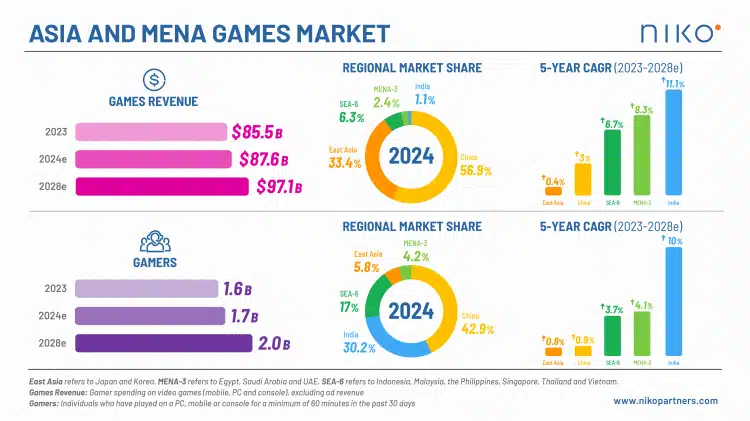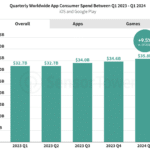The Asia and MENA games market is on an impressive growth trajectory, with projections indicating that it will generate nearly $100 billion by 2028. According to a newly released report by Niko Partners, this surge will be driven primarily by the rapid expansion in India, the MENA region, and Southeast Asia. These regions are set to become the fastest-growing markets in the gaming world, with India expected to lead the charge by adding 277 million gamers by 2028, which will constitute 72% of the total growth in gamers across Asia and MENA over the next five years, surpassing even China.
In 2023, the Asia and MENA regions accounted for approximately 57.8% of global player spending on mobile games, which translates to a significant share of the $100.5 billion global mobile games market. The prevalence of mobile gaming in these regions is striking, with 93.7% of gamers playing on mobile devices. This contrasts with the 35.1% who play on PC and the 4.9% who use consoles, highlighting the mobile-centric nature of the gaming culture in these areas.
PC gaming also holds a formidable presence in the Asia and MENA markets, contributing to 50.4% of global player spending on PC games in 2023. This represents a substantial portion of the $39.2 billion global PC games market. China, the largest games market worldwide by revenue, underscores the importance of PC gaming, with more than 28% of its total gaming expenditure dedicated to PC games.
Among the regions tracked, India emerges as the fastest-growing market, followed closely by the MENA-3 countries (Saudi Arabia, UAE, and Egypt). This growth contrasts with the slower expansion anticipated in more mature markets like Japan and South Korea. The rapid increase in the number of gamers in India is particularly noteworthy, as it signals a fundamental shift in the global gaming landscape, positioning India as a key player in the industry’s future.
The report also highlights a significant rebound in gaming hours across Asia. After experiencing a 10% decline in average weekly gaming hours in 2023, the region has seen a remarkable 36.2% year-over-year increase. This resurgence indicates a renewed enthusiasm and engagement in gaming, likely fueled by the growing accessibility of games and the increasing penetration of smartphones and internet connectivity.
“Asia and MENA remain critical in the global games market, and drivers to the growth in these regions include localization, increased participation by female gamers, government support for esports, growth of out-of-app monetization of mobile games, and rising spending power,” said Lisa Hanson, CEO of Niko Partners. She emphasized the importance for companies to understand local market realities and the context behind the data used for strategic planning. Companies seeking meaningful market entry must invest in gaining in-depth knowledge of these regions’ unique cultural and economic landscapes.







Comments
Loading…